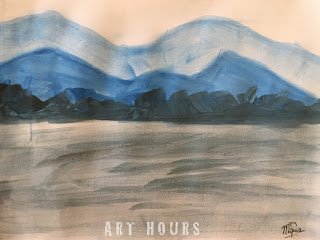Watercolor has been personally my favorite medium amongst the other wide array of mediums available till date. Using watercolors has made me explore its various techniques and possibilities that probably no other medium offers. As I mentioned in the earlier post that we will be doing a lot of watercolors this month, here's a small exercise we did at Art Hours, which our students also enjoyed doing was on 'Transparency'.
Firstly, it is important to understand, how you can best use the medium. Though on first hand, it may look easy, watercolor is not very easy to handle, especially, if you are not aware of the techniques. You can end up with a messy work for sure. So it is recommended that you master the simple techniques first and keep exploring...
You can study and observe other artists' work too which will help you to understand a lot of things about how they have used and explored with watercolors.
This post focuses on transparency - one of the unique characteristics of watercolors that help in capturing beautiful scenes say for example: creating waterscapes, the blues of the sky, different layers of landscapes and so on...
Now, to understand the transparency effect better, we have done a small exercise to start with.
Here's what you will need for this exercise:
1. Watercolors - Any brand will do
2. A Flat Brush - we used @1 inch wide flat brush
3. Clear Water
4. A Sketch Book - the paper quality should be thick enough to absorb the water and not start puddling.
 |
| Materials required for Transparency Exercise |
Draw as many rectangles you wish from top to bottom, leaving a little white gap in between every strip. Here, I have created 7 rectangular blocks to start with.
 |
| Transparency Exercise |
Take out the selected color in a color palette and add water to it. Make it thick like Milk consistency. I have taken out a little of the dark blue color in the small space provided within the watercolor box itself, as you will see in the picture below.
 |
| Preparing the color |
Start with the first block. Add the color using a flat brush on the first one. Thereafter as you go to the next rectangle, dilute the paint with very little water and paint the 2nd rectangle. Keep adding water and add them one by one on every rectangle till you reach the bottom where you are left with the color with maximum dilution. Do not rinse the brush at any stage. By the end of the process, you would have created 7 blocks with a gradual transition from a dark shade to a transparent shade.
Here's what some of our Students at Art Hours have done with their exercises on Transparency.
 |
| Students' Exercise on Transparency - with 5 shade blocks |
 |
| Students' Exercise on Transparency - with 7 shade blocks |
How does transparency help in watercolors? Well, you will know when you start using them yourself. Here's a small sample of what you can do with the transparency technique. Create landscapes and more...
 |
| A Mountainside scene created using transparency technique |
The above mountainside scenery uses only graduated wash of blue to add every layer of the mountain. For the dark layer just near the waterbody, add a little black to separate the waterbody from the mountains. For this entire painting above, only a 1" wide flat brush was used.
For the next painting, you will see how we created different layers by just using the transparency technique. Once the base was ready we added details to get a beautiful scenery of the house by the lake.
 |
| Step 01: Gradient wash using different colors. |
We started from the top using an orange, then blended it with yellow, then blue and finally violet. Thereafter, we started adding little details such the house using the browns, followed by the layer of greens. We created layers of the mountains behind the house by slowly graduating blues and also added some blues to the lake. The boat was a final addition to the lake.
 |
| Step 02: A House by a Lakeside |
The above paintings may not be perfect samples of water coloring exercises, and you must definitely look out for more work done by other popular artists. One particular artist that comes to my mind is JMW Turner who has made some beautiful paintings that help us in understanding the use of colors and light especially if you wish to understand marine paintings.
I hope the above tutorial on helps you in understanding the basics of using transparency in watercolors. Hope to post more tutorials this month...so keep looking out for this space...there is more on watercolors coming this month.
---

No comments:
Post a Comment